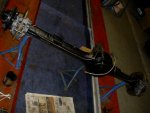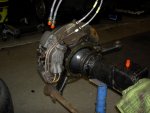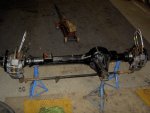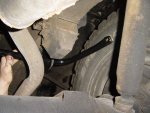Toy-Roverlander
Adventurer
Hi folks.
The idea of fitting Range Rover axles to my IIa has been floating through my mind for a while. Last year I bought an old heap of a Rangie for a carton of beer, so that's a good start.
I took the axles off and grinded off everything that has to do with coil suspension. Then I stripped them completely. One swivelball was fine, the other was replaced.
I replaced everything, swivelball, swivel pins, bearings, swivel seals, wheelbearings and hubseals.
Then I went to Africa for 2months so the axles got stored till I got back.
A couple of days ago, when out on a drive, I braked a bit harder than I usually do and it pulled to the right. Quite badly too.
At that point I made the decision to fit the Rangie axles asap. I've had it with those stupid crappy drum brakes. It's all been renewed less than 3years ago and it has never worked properly. So this was the last straw.
No more brake drums with no booster....
So I pulled the axles out of storage, ordered some more parts I needed (I'll be fitting parabolics up front and new U-bolts and shackle bolts and such all round) and finished of what I should have done last year. Refurbishing the calipers.
So that's what I've been doing the last couple of days, fitting new seals and stainless steel pistons to the calipers, fitting the Rangie booster and M/C to the SeriesIII pedal unit and fitting the calipers to the axles together with new copper brake pipes and goodrich hoses.
The axles are nearly ready to be fitted to the 109". All I need to do now is make the spring mounts that need to be welded onto the axle and the rear shockabsorber mountings too.
The only problem with Rangie axles is the fact that the trackrod wants to go through the leaf springs. There are some solutions for this problem, some of them good, some of them bad.
I've choosen for the safe option, making the spring mounts a bit taller. This way the trackrod will clear the top of the springs easily and this way no welding to the trackrod or whatever is needed.
And for that reason I'll be fitting parabolics to the front axle. As the spring mount will be around an inch taller than usual, the front would drop an inch.
Now with para's I will gain an inch, instead of 2 as I loose 1inch.
The rear springs are supersoft sagged stationwagon springs so I'll be keeping those. I did order new ones as I want to replace the main, 2nd, 6th and 7th leaf. This will raise the back end slightly, and together with one-ton shackles the back will end up slightly higher than the front.
The rear springs are completely flat at the moment, but the Landy still sits level as the front mount is lowered 3cm and the rear turret is 5cm talles than normal. So with flat springs it sits level, hence I don't want to fit para's to the rear axle as this will raise the rear too much.
I've got massive flex from these flat springs as it quite badly reverse arches, so I've got some extra suspension travel . It's got so much bump travel that the wheel (a 7.50) hits the wheelwell while the axle still sits an inch from the bumpstop, and droop is so much that the top of the wheel comes down to the bottom of the sills.
. It's got so much bump travel that the wheel (a 7.50) hits the wheelwell while the axle still sits an inch from the bumpstop, and droop is so much that the top of the wheel comes down to the bottom of the sills.
Anyway, with the Rangie axles I'll get more articulation (wider axles and front para's), a better turning circle and best of all, DISC BRAKES!!!!! Awesome!!
Here's some pics of the axles.
Hopefully all the stuffed I ordered from the UK will come in tomorrow, then I can start first thing next monday.
Here's a little list I have to do.
- take front wings, bonnet and bullbar off
- get rid of current brake M/C and pedal unit, including clutch unit and M/C
- fit the new pedal unit with booster and M/C, including new clutch M/C
- remove rear axle and springs
- take springs apart and reassemble with new leafs in old spring pack
- fit spring mounts, springs and U bolts to axle and trial fit to get prop angle right, adjust spring mount as necessary. Also do shock mounts.
- remove axle and fully weld spring and shock mounts, rustproof/paint axle
- fit rear axle and springs
- remove front axle and springs as one unit
- fit spring mounts, u bolts and para's to axle
- trial fit axle and adjust spring mounts as necessary to get proper castor angle. (prop angle will be of, but not a problem on a mate's 88" with Def axles, and his has para's with one-ton shackles. The lift on mine is less and the propshaft is about 10inch longer due to Toyota engine/transmission)
- remove axle and fully weld spring mounts, rustproof/paint axle
- refit axle.
- fit all brakepipes and connect the whole bunch up, including vacuum hose
- bleed brakes, check for leaks
- refit bonnet, wings, bullbar
- GO AND ENJOY THE NEW PROPER BRAKES!!!!!!!
Quite a project, but very much worth it!!
:sombrero:
Koos
The idea of fitting Range Rover axles to my IIa has been floating through my mind for a while. Last year I bought an old heap of a Rangie for a carton of beer, so that's a good start.
I took the axles off and grinded off everything that has to do with coil suspension. Then I stripped them completely. One swivelball was fine, the other was replaced.
I replaced everything, swivelball, swivel pins, bearings, swivel seals, wheelbearings and hubseals.
Then I went to Africa for 2months so the axles got stored till I got back.
A couple of days ago, when out on a drive, I braked a bit harder than I usually do and it pulled to the right. Quite badly too.
At that point I made the decision to fit the Rangie axles asap. I've had it with those stupid crappy drum brakes. It's all been renewed less than 3years ago and it has never worked properly. So this was the last straw.
No more brake drums with no booster....
So I pulled the axles out of storage, ordered some more parts I needed (I'll be fitting parabolics up front and new U-bolts and shackle bolts and such all round) and finished of what I should have done last year. Refurbishing the calipers.
So that's what I've been doing the last couple of days, fitting new seals and stainless steel pistons to the calipers, fitting the Rangie booster and M/C to the SeriesIII pedal unit and fitting the calipers to the axles together with new copper brake pipes and goodrich hoses.
The axles are nearly ready to be fitted to the 109". All I need to do now is make the spring mounts that need to be welded onto the axle and the rear shockabsorber mountings too.
The only problem with Rangie axles is the fact that the trackrod wants to go through the leaf springs. There are some solutions for this problem, some of them good, some of them bad.
I've choosen for the safe option, making the spring mounts a bit taller. This way the trackrod will clear the top of the springs easily and this way no welding to the trackrod or whatever is needed.
And for that reason I'll be fitting parabolics to the front axle. As the spring mount will be around an inch taller than usual, the front would drop an inch.
Now with para's I will gain an inch, instead of 2 as I loose 1inch.
The rear springs are supersoft sagged stationwagon springs so I'll be keeping those. I did order new ones as I want to replace the main, 2nd, 6th and 7th leaf. This will raise the back end slightly, and together with one-ton shackles the back will end up slightly higher than the front.
The rear springs are completely flat at the moment, but the Landy still sits level as the front mount is lowered 3cm and the rear turret is 5cm talles than normal. So with flat springs it sits level, hence I don't want to fit para's to the rear axle as this will raise the rear too much.
I've got massive flex from these flat springs as it quite badly reverse arches, so I've got some extra suspension travel
Anyway, with the Rangie axles I'll get more articulation (wider axles and front para's), a better turning circle and best of all, DISC BRAKES!!!!! Awesome!!
Here's some pics of the axles.
Hopefully all the stuffed I ordered from the UK will come in tomorrow, then I can start first thing next monday.
Here's a little list I have to do.
- take front wings, bonnet and bullbar off
- get rid of current brake M/C and pedal unit, including clutch unit and M/C
- fit the new pedal unit with booster and M/C, including new clutch M/C
- remove rear axle and springs
- take springs apart and reassemble with new leafs in old spring pack
- fit spring mounts, springs and U bolts to axle and trial fit to get prop angle right, adjust spring mount as necessary. Also do shock mounts.
- remove axle and fully weld spring and shock mounts, rustproof/paint axle
- fit rear axle and springs
- remove front axle and springs as one unit
- fit spring mounts, u bolts and para's to axle
- trial fit axle and adjust spring mounts as necessary to get proper castor angle. (prop angle will be of, but not a problem on a mate's 88" with Def axles, and his has para's with one-ton shackles. The lift on mine is less and the propshaft is about 10inch longer due to Toyota engine/transmission)
- remove axle and fully weld spring mounts, rustproof/paint axle
- refit axle.
- fit all brakepipes and connect the whole bunch up, including vacuum hose
- bleed brakes, check for leaks
- refit bonnet, wings, bullbar
- GO AND ENJOY THE NEW PROPER BRAKES!!!!!!!
Quite a project, but very much worth it!!
:sombrero:
Koos






